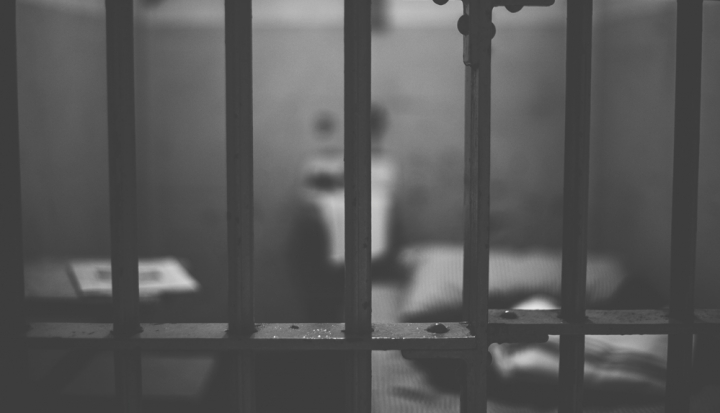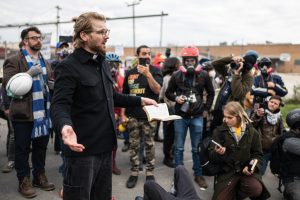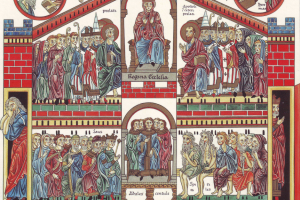About 25 years after the brutal murder of her older sister, Jean Parks unearthed her true feelings about the death penalty.
At a meeting of San Antonio’s chapter of Parents of Murdered Children, convened by Parks, an official from the Department of Corrections spoke to the group. He invited murder victims’ families to attend the execution of their child’s convicted killer, describing how they could arrive early for a tour of the facilities. The department would assign the family a staff person and provide them with coffee and donuts. No such accommodations, he noted, would be offered to the family of the condemned.
In that moment, a light flickered on in Parks’ soul. “I imagined myself with a family member about to be executed,” she says. “The helpless anger, hurt, and grief of not being able to prevent a loved one’s death were so similar to what my own family experienced after my sister’s death that I couldn’t understand why our government would do such a thing.”
The death penalty, Parks is quick to point out, can compound a murder victim family’s grief. “Taking another life,” Parks explains, “does not bring peace or healing.”
Parks cites her baptismal vows in the Episcopal tradition as forming her sense of conscience on capital punishment. In loving her neighbor, resisting evil, striving to enact peace and justice, respecting the dignity of every human being, and proclaiming the love of Christ, Parks arrived at a resolute truth: “I don’t think God ever gives up on us, so there’s always a possibility that a person will turn to God and repent. If we kill them, we steal the possibility of redemption,” she says.
Pope Francis affirmed the same on August 2, 2018, when he declared the death penalty inadmissible in all cases, revising the Catechism of the Catholic Church to reflect this unequivocal teaching. The catechism now reads: “Today . . . there is an increasing awareness that the dignity of the person is not lost even after the commission of very serious crimes.” In the pope’s 2015 letter to the president of the International Commission against the Death Penalty, he expressed concern regarding “the defective selectivity of the criminal justice system and . . . the possibility of judicial error.”
The pope’s resolve on this life-and-death issue, however, poses a particular challenge to the Catholic Church in the United States, where Catholic justices constitute a majority on the Supreme Court. In the United States, 53 percent of Catholics still support the death penalty, a Catholic governs the state that executes the most criminals, and the pro-life movement often fails to extend its advocacy to prisoners on death row. It remains unclear whether the pope’s decisive change to the catechism will impact implementation of the death penalty, shifting the momentum toward abolition in the United States.
However, there are some signs that change is coming. Some Catholics have examined the criminal justice system’s racial bias, wrongful convictions, and botched executions, shining a light on the death penalty’s ethical failings. These Catholic leaders are working toward the full development and use of restorative justice practices in order to honor the essential dignity of every human life.
Racial bias in death sentencing
In March California Governor Gavin Newsom employed his executive power to halt the death penalty in that state, granting reprieve to all 737 inmates living on death row. Newsom claimed he could not support “a racist system” by allowing anyone to be put to death on his watch. In North Carolina, however, where Betsy Parks Rosenberg, Jean Parks’ sister, was murdered, unprecedented efforts to address what Pope Francis calls “the defective selectivity of the criminal justice system” have been met with resistance.
Researchers Catherine Grosso and Barbara O’Brien, professors at Michigan State University’s College of Law, conducted a groundbreaking study on racial bias in death sentencing in North Carolina, finding systemic racial bias in jury selection: 52.6 percent of otherwise qualified black citizens were struck from juries in cases seeking the death penalty, compared to just 25.7 percent of all other citizens.
Kenneth Rose, former executive director of the Center for Death Penalty Litigation, describes the implications of this bias, citing an ACLU report: “Of the 159 prisoners now on death row in North Carolina, 31 were sentenced by all-white juries and another 38 had only one person of color on their sentencing juries.”
The MSU study revealed “huge knots of racial discrimination in the criminal justice system,” Rose says. “Based in part on this study, a state court judge found pervasive racial discrimination in jury selection in capital trials conducted across the state over a 20-year period. Those findings have never been contested. The criminal justice system was never working equitably, but now we have the data to prove it, and legislators are trying to cover it up.”
A second MSU study demonstrated that people charged with murdering white victims were sentenced to death at more than twice the rate as people charged with murdering people of color.
In response to this demonstrated bias, grassroots community organizing efforts galvanized impacted communities, faith leaders, pro bono lawyers, and candidates running for office. As a result, in 2009 the North Carolina General Assembly passed the Racial Justice Act, which provided an avenue for death row inmates to appeal their sentencing based on evidence of racial bias.
Under the Racial Justice Act, four individuals were granted relief and transferred off death row into the general prison population, where they would serve a life sentence without parole. However, the state appealed all four cases; before they landed in the Superior Court, the Racial Justice Act itself was gutted, then repealed. The cases were dismissed, and the inmates were transferred back to death row. Their cases are currently under appeal.
Wrongful conviction
Rose cites projections that 4 percent of people on death row are, presumably, innocent. With few effective mechanisms to prove those persons innocent in a court of law, many will likely be executed.
“This is the most profound moral injustice,” Rose says. “The pope has looked practically at how the death penalty is applied. The justice system is made up of flawed human beings with biases. Police officers, juries, defense attorneys, judges—we all have biases. The pope’s position is hard to dispute.”
According to the Death Penalty Information Center, 165 people have been exonerated from death row in the United States, 1 for every 10 executions carried out. Even in cases of exoneration, however, Rose describes agonizing years when the knowledge of his client’s likely innocence ran up against the slow slog of the courts.
One of Rose’s clients, Henry McCollum, served 30 years on death row before he was exonerated. McCollum would often ask, “Why am I here? You know I don’t belong here.” Rose had no explanation to offer.
Even if eventually exonerated, inmates often face a difficult reentry into life outside of prison. The trauma of years stolen, false accusations, and broken relationships haunts them.
Glen Edward Chapman is no exception. Chapman served 14 years on death row in North Carolina for a crime he did not commit due to corruption in the police investigation, a false accusation, and an inadequate legal defense.
In his multiple public appearances following his release, Chapman admitted he was often in trouble with the law before his arrest. This placed him in the position, he insisted, of being considered a suspect. Chapman said he “did his crying” over his wrongful conviction the first couple years in prison but slowly transformed himself into a humble, faith-filled man.
Chapman was released from death row with 10 minutes’ notice and no money, housing, or transportation. “I’m tired, but not angry,” he said initially.
For years after his release, Chapman struggled to make ends meet and to sustain employment in low-wage jobs. He’s recently fallen out of touch with longtime friends and community advocates.
His story’s troubling turn is not unusual for exonerees. Losing years of life and opportunities such as raising one’s children may be a grief too burdensome to bear.
“Nobody wants an innocent person in prison, regardless of your party affiliation,” says Mark Godsey, author of Blind Injustice: A Former Prosecutor Exposes the Psychology and Politics of Wrongful Convictions (University of California Press). “This is not a political issue, and innocence work aligns with both parties.”
In Ohio, Godsey’s work with the Innocence Project has freed 28 people who collectively served 525 years imprisoned for crimes they did not commit. The organization’s advocacy helped pass legislation in 2010 that requires law enforcement to record interrogations with suspects, collect and preserve DNA evidence in a consistent manner, and follow a new protocol for witness identification.
Godsey notes that it’s hard to argue with innocence reforms given their pragmatism, saying, “It’s no-brainer stuff, everyone should do it.”
In the case of Jean Parks, the possibility of wrongful conviction ached like a thorn in her side. She was a 20-year-old sophomore at Davidson College when her sister Betsy Rosenberg, four years older, was found beaten to death next to her vehicle across the street from the North Carolina State University library.
At the time, Betsy was newly married, finishing up her degree in accounting, and working part time. Although always at different schools due to their age gap, during Betsy’s last visit home Parks recalls sharing a thoughtful conversation that glimmered with the hope of a deepening friendship as adults. “I felt robbed of that opportunity,” she says.
In truth, the Parks family was robbed of much more, including certainty about whether the man who was serving a life sentence for Betsy’s murder was guilty of the crime. Following Betsy’s death, the press pursued a sensationalized investigation of the young woman’s mysterious murder. The original suspects in the case were not charged, due to lack of evidence. Gary Goldman, a man already serving time in Georgia for another murder, was convicted and sentenced to life with the possibility of parole. He was 17 when the crime was committed.
Not persuaded of his guilt, Jean Parks could only refer to him as “the man convicted” of her sister’s murder. “I had reasonable doubt,” she confesses. As time went on and Goldman’s conviction was not overturned, Parks began to assume he must be guilty.
About 20 years after her sister’s murder, Parks learned about the restorative justice practice of victim-offender dialogue. Following a move back to North Carolina, Parks pursued the opportunity to contact Gary Goldman with the help of a restorative justice facilitator in 2011. But Raleigh’s Central Region Office–Prisons denied her request.
Later, an attorney advised making another request directly to the unit where Goldman was being held. This time Parks received permission to pursue dialogue. The first message she received from Goldman, however, stated that he was willing to meet but could not answer her questions, since he had not been involved in Betsy’s murder.
It was the first time Parks realized that the man convicted of her sister’s murder had maintained his innocence all along. The North Carolina Center on Actual Innocence was investigating his claim, and some working with him, notes Parks, were “convinced he’s innocent.”
At first, the Raleigh Police Department maintained there was no remaining evidence from the case, “but things have appeared,” Parks says, including the sheet in which Betsy’s body was wrapped. DNA testing produced a profile that did not match that of Gary Goldman.
The weary pain in Parks’ voice is palpable as she speaks of the terrible burden of not knowing who killed her sister or whether the person punished committed the crime. Ultimately her suspicion of Goldman’s innocence led Parks to advocate for his parole. In May 2019, after serving more than three decades for Betsy Rosenberg’s murder, Goldman was paroled. Of Parks’ support he said, “It was unbelievable. I was stunned and so grateful.”
The trouble with lethal injection
In 2018 over half the nation’s executions took place in the Lone Star State. Since 1976 Texas has executed 561 persons, with at least three found innocent after their execution. While Texas’ constitution expressly forbids a governor from imposing a moratorium on the death penalty, Governor Greg Abbott, a Catholic himself, still possesses the power to grant clemency to any individual prior to their execution. In February 2018, Abbott issued his first and only clemency.
Just prior to Abbott granting clemency, the first two executions of 2018 in Texas were reportedly botched due to the use of aged and poorly administered sedatives. One priest who served as a spiritual director to Anthony Shore, executed on January 18, reported in a sworn affidavit that as the sedative was injected into Shore’s veins, his body trembled, he spoke in stressed tones of a burning sensation, and he struggled desperately to breathe.
Witnesses in seven states over the past decade have noted indicators of severe pain following the first injection—including audible groans, violent convulsions, gasps for air, and facial contortions. Executions in Ohio are currently delayed as the state seeks new lethal injection drugs. A specific drug required by Colorado law is no longer available on the open market, which has heightened debate and may result in the abolition of the death penalty in that state.
Meanwhile, Nebraska has become the first state to execute a prisoner with fentanyl, the same drug killing unprecedented numbers of Americans ensnared in opioid addiction. Krisanne Vaillancourt Murphy, executive director of Catholic Mobilizing Network (CMN), the national Catholic organization seeking to end the death penalty and promote restorative justice, points out that some death row inmates are now opting for the electric chair due to fears over botched lethal injections. In truth, she adds, “there is no humane way to kill a person.”
The increasingly cruel and unusual method of lethal injection further illustrates Pope Francis’ proclamation that the death penalty fails to uphold human dignity. “The circles of injury in our criminal justice system ripple out from the executioners themselves, to all those responsible for the execution, all the way to us as citizens who allow a system to continue that executes human beings,” notes Catholic leader Marie Dennis.
Despite the fact that Abbott has declined to halt the machinery of death, and his state has executed eight more prisoners since the pope’s declaration, Vaillancourt Murphy insists that the culture is beginning to shift, and Catholics play a significant role. “At CMN we have noticed an uptick in how many social ministry offices have contacted us seeking resources on the issue of capital punishment to equip them to educate, pray, and advocate more deeply with their parish and diocesan communities,” she says.
Restorative justice
Ultimately, the pope’s revision of the catechism may not tip the scales toward abolition of the death penalty, but rather nurture the conscience of the generation coming of age in today’s Catholic Church.
Marie Dennis, copresident of Pax Christi International, says, “Our focus has been on deepening and strengthening the commitment to peace and reconciliation in the Catholic Church, and we believe there is a very rich gospel basis for that. As a movement we understand nonviolence as a spirituality, way of life, and powerful methodology for dealing with many kinds of violence.” The deep conversations between the Vatican and Pax Christi International likely helped to cultivate the soil for the pope’s declaration. “We have to believe it is possible to live another way,” Dennis says.
To that end, Catholic engagement on the death penalty runs the gamut from the formation of individual conscience to state-by-state advocacy and experimental efforts to build new models to seek justice and resolve conflict. “In our world we live constantly with overwhelming expressions of violence: gun murder, poverty, racism, a criminal justice system focused on punishment that too often dehumanizes criminals and ignores the suffering of victims,” says Dennis. “We believe there are powerful alternatives, and people everywhere are hungry to create alternatives more attuned to the essential dignity of human life.”
Restorative justice models focus on holding the perpetrator accountable and transforming relationships based on victims’ needs. One example is victim-offender dialogue, a deliberate process that can offer deep healing for both parties. Not only does the criminal justice system fail to facilitate this kind of restorative justice, it often prevents it.
Other restorative justice practices include interrupting the violence of poverty and racism, off-ramping young people from incarceration, and restorative circles that implement Native American wisdom by inviting people to share their truth in the round using a talking stick.
According to Vaillancourt Murphy, “Restorative justice is not soft on crime. It is not an easy way out. It is not letting things go or quick to forgive. It asks very different questions from the criminal justice system, such as: What was the harm? Who was affected? What should be done to repair the harm or to make amends?” Schools and communities of faith are beginning to adopt and share restorative justice practices to solve conflict, address abuse, and empower youth leadership. “Hurt people hurt people, but the converse is true too: Transformed people transform people,” Vaillancourt Murphy says.
Jean Parks exemplifies this truth, as she doggedly travels around North Carolina to share her story. Gary Goldman walking free is now part of her lived commitment to restorative justice. The real change, according to Marie Dennis, “comes not only from ideas, but from encounter and community.”
The backstories of childhood trauma, mental illness, poverty, and racism that precipitated a perpetrator’s crime; the exoneree’s story of the kernel of hope found within struggle; the incomplete story of a murder victim; the grave harm that forever bends the story of a victim’s family—each one has painful truths to tell, wounds to reveal, a hunger to be made whole. If faith is the substance of things hoped for, then those affected by the death penalty will welcome the pope’s declaration.
For more resources on how to get your parish involved in restorative justice, check out the Catholic Mobilizing Network.
This article also appears in the August 2019 issue of U.S. Catholic (Vol. 84, No. 8, pages 32–37).
Image: Pixabay













Add comment